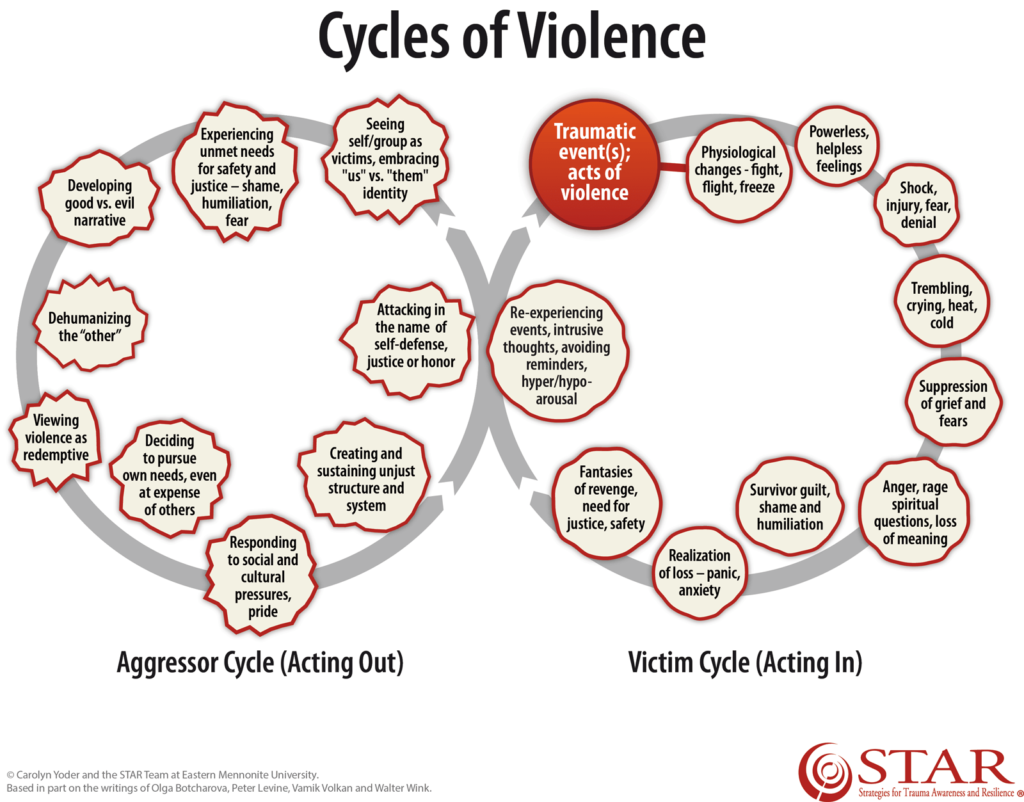Unaddressed Trauma
Ignoring trauma does not make it go away
It is understandable why we as humans want to ignore trauma. Our cultures tell us we should “get over it” and “get back to normal” as soon as possible. We don’t want to look – or feel – weak. We may fear that we’ll be overwhelmed and fall apart if we talk about it.
We may even believe that if we’re not suffering from full-on PTSD (Post-Traumatic Stress Disorder), the trauma hasn’t affected us.
But time alone does not heal all trauma wounds. Much like a physical wound that doesn’t heal, unaddressed trauma can fester. The result is violence and even more trauma.
In this page, you’ll find information about:
- What happens – both to individuals and communities – when trauma is ignored
- The cycles of violence: acting in, and acting out
- What to do to help members of your community begin to address trauma
Unhealed trauma results in cycles of violence
When we ignore the impact of a devastating event or of traumatic situations that are on-going, the unreleased energy from the flight, fight freeze response remains trapped in our bodies. It makes us hyper-aroused or numb or we alternate between the two extremes.
The meaning we give to what happened (e.g. “It was all my fault,” or “I’m going to get them back”) eats away at our minds, bodies and spirits.
The impact of carrying these wounds of trauma wounds takes its toll. The normal trauma reactions we experienced initially morph into something more sinister: cycles of violence.
How you can tell when normal trauma reactions have changed into cycles of violence
Hurt people hurt people.
Observe the behaviors of families, community, national and international relations. The quality of our relationships is a good measure of well-being. When we as humans carry the energy of trauma, we take it out on ourselves (acting in) and others (acting out).
The diagram below names a number of these behaviors. Hold your cursor over the print to magnify or click to enlarge the entire diagram.
The Victim Cycle (Acting In) Explained
If you look carefully at the Victim Cycle, you’ll notice that the reactions described are identical to the Normal Trauma Experience diagram with two important exceptions:
- The title of this circle is the victim cycle, and
- The enclosures around the words are jagged rather than smooth
The Victim Cycle is simply normal initial trauma reactions that have become stuck. The red print inside the cycles (run your cursor over the diagram to make visible) gives examples of behaviors that result from the unreleased trauma energy and from the meaning we give to what happened. They are called acting in behaviors because the energy is turned inward, against ourselves. We become a victim of what happened.
We can stay in the Victim Cycle for months, years or generations.
Notice that there is another possibility for victims: the two cycles touch in the middle. Victims can also become aggressors, and they often do. You can read more about the Aggressor Cycle below the diagram.
The Aggressor Cycle (Acting Out) Explained
When we “act out,” we turn the energy of the unaddressed trauma out against others. If another person or group is responsible for causing the trauma—or is perceived to be responsible–it’s very easy for victims to become aggressors by attacking them in some way.
This is true whether the trauma is a bitter divorce, a terrorist attack or a war.
The outer ring of the Aggressor Cycle traces the familiar (but unusually unconscious) steps that individuals, communities or societies often follow when attacked or harmed by others.
The meaning we give to what happened through the stories we tell are framed in themes of “good and evil” or “us versus them.” This makes attacking others seem justified, noble and patriotic.
The counter attack against others can be verbal (screaming at someone) or physical (slapping a spouse). It can range from playground bullying to bombing another country. The red print in the middle of the diagram gives examples of acting out behaviors.
A counter-attack creates trauma for the person or population. They then feel justified in attacking back.
And so begin the kind of tit for tat cycles of violence that we see on our television screens and in newspapers every day.
Cycles of violence can go on for generations
Unless the cycles of violence are broken, they often evolve into complex conflicts. Those conflicts can then have devastating, deadly effects not only on those involved, but the families, organizations, and communities that surround them. And conflicts often spread not just through the present generation, but down through future generations as well. For peace and healing to happen, we need to each be willing to recognize and break our cycles of violence.
Genealogist and author Sharon Leslie Morgan discusses the Cycles of Violence model in light of her own experience:
Important Note: Being caught in one of these cycles is NOT the same thing as experiencing PTSD (Post-Traumatic Stress Disorder). PTSD is one consequence of trauma, but it is only one of many.
Community members do not need to be suffering from PTSD to benefit from addressing and healing from the effects of the trauma they have been through.
What to do to help people and communities caught in the cycles of violence
If you are seeing signs of the acting in or acting out cycles of violence in your community, the Cycles of Violence diagram can be used to start conversations on the devastating effects of ignoring trauma.
Use the Healing tools and processes on the next page to help you identify ways to work with those affected to examine the meaning of what happened, seek justice in non-violent ways, and to identify and address the root causes.

